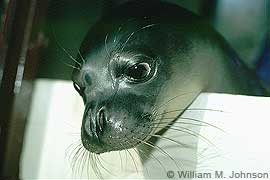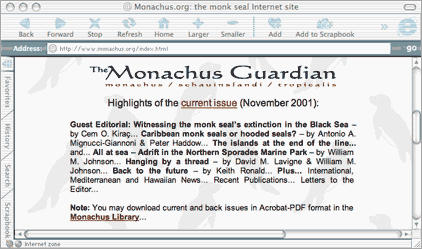

 |
||
 |
||
Vol. 7 (1): June 2004 |
Download this page
|
|
Seal AppealSupport monk seal conservation. Help us stay on line. The Monachus Guardian is the only dedicated source of news and information on the world's endangered monk seals. Its publication fulfils explicit recommendations of conservation action plans for the species. The Monachus Guardian is now accepting donations and voluntary subscriptions from its readers via Kagi, the leading Internet service that ensures swift, secure online payments by credit card. Kagi accepts American Express, Cart Blanche, Diner's Club, Discover, EuroCard, JCB, Optima, Nova, MasterCard and Visa credit and debit cards. If you want to help us help the world’s endangered monk seals, please consider...
|
 |
|
|
|
The Mediterranean monk seal was voted Europe’s “cutest” endangered species in an international survey conducted in April 2004.
Respondents from around the world participated in the web-based poll, conducted by WWF United States. The monk seal achieved 47% of the vote, with the Eurasian lynx following closely at 43% and the Sea Horse trailing at 9%.
“In a race that went down to the wire,” reports WWF, “the monk seal overtook the Eurasian lynx in the final days to win the title of Europe's cutest animal. The feline family threatened to send a second member to the finals, but seal lovers worldwide put an end to that dream.”
Despite the rather odd spectacle of endangered and persecuted species competing with each other for human affection, the survey did demonstrate one thing in no uncertain terms: the Mediterranean monk seal’s broad potential in terms of public appeal.
More than fund-raising promise, however, is the species’ ability to capture the public imagination, and to symbolise the devastating threats that confront both seal and the Mediterranean ecosystem as a whole: mass tourism, industrial overfishing, habitat destruction, pollution.
Anyone who has been following monk seal conservation over the last 25 years or so will have long lost count of the conference resolutions, scientific recommendations, project proposals, telexes, faxes, emails and letters that have tried to convey the persuasiveness of that idea to governments, institutions and organisations.
A failure by the conservation movement to capitalise on the monk seal’s potential may be one reason why vital projects for the species remain chronically starved of funds – including the guarding of marine protected areas, and even rescue and rehabilitation of orphaned pups.
For one reason or another, international conservation organisations have never mounted a concerted, international campaign on behalf of Europe’s most endangered marine mammal. Some have even withdrawn from the conservation of the species of late, apparently seeing better prospects or more important priorities, elsewhere.
But as the “world’s cutest” poll has demonstrated loud and clear, that reluctance to champion the cause of the monk seal is flawed on every possible level: financial, educational, ecological.
Whether conservation multinationals will ever wake up to their squandered opportunity remains to be seen. – W.M.J.
We apologise to readers who have been led astray by the apparently defunct web site – and former home of The Monachus Guardian – www.monachus.org. We have been reliably informed that work is at last underway by IFAW/IMMA to set up valid links to TMG, thereby finally disabusing visitors of the idea that the “current issue” of the journal is “November 2001”.
 |
We also apologise to those visitors to have tried to contact us through the old editor, webmaster and librarian email addresses @monachus.org. These have not been accessible to us for a considerable period of time; for some indeterminate period during 2002-2003, such emails may not have generated non-delivery error messages.
NetWatchMonk seal Lives: Mediterranean Sea region Diet: Fish Threats: Collisions with boats, bycatch, water pollution
|
Copyright © 2004 The Monachus Guardian. All Rights Reserved |